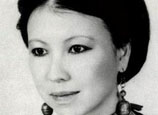
 |
| The four parts of the floral motif are interlocking pieces. (China Daily) |
The dominant style formed during this period, famously known as the "Ming Style", eschewed any superfluous decoration for a deliberate minimalism, or an understated luxury to use the modern lexicon.
"The style is a direct reaction to all the sumptuousness of the preceding era, and is underwritten by the belief that while sophistication exacts the eye, simplicity trains the mind," says Gao Shuzhen, founder of the Nanmu Studio which is behind the National Museum show.
"And that ideal triumphed during the Ming Dynasty."
Although style temporarily yielded to a much more elaborate and ornate aesthetic during the Qing Dynasty (1644-1911) which followed, "Ming Style" has reinforced itself as the current paragon of classical Chinese furniture-making especially as modern collectors and connoisseurs initiated a society-wide search for "our cultural roots".
As for his father's sage saying about "wood cultivating people", the 41-year-old Mi has finally arrived at his own conclusion.
"A master carpenter and his chosen piece of wood - they both have their own temperaments. The relationship between them can be best described as a love affair. The craftsman is determined to turn natural beauty into a work of art with timeless appeal, investing countless hours of hard work and total concentration of mind and soul," Mi says.
"By doing so, he brings out the best in himself and becomes complete."



















![]()
